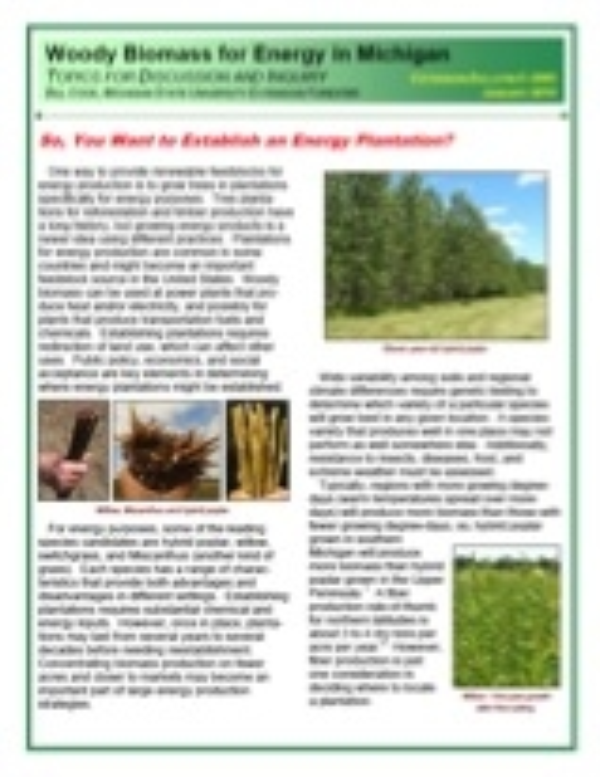
Bulletin E3095
Woody Biomass for Energy in Michigan: So, You Want to Establish an Energy Plantation?
DOWNLOAD
August 20, 2015 - Bill Cook
So, You Want to Establish an Energy Plantation?
One way to provide renewable feedstocks for energy production is to grow trees in plantations specifically for energy purposes. Tree plantations for reforestation and timber production have a long history, but growing energy products is a newer idea using different practices. Plantations for energy production are common in some countries and might become an important feedstock source in the United States. Woody biomass can be used at power plants that produce heat and/or electricity, and possibly for plants that produce transportation fuels and chemicals. Establishing plantations requires redirection of land use, which can affect other uses. Public policy, economics, and social acceptance are key elements in determining where energy plantations might be established.
Figures 1, 2, and 3. Willow, Miscanthus, and hybrid poplar.
For energy purposes, some of the leading species candidates are hybrid poplar, willow, switchgrass, and Miscanthus (another kind of grass). Each species has a range of characteristics that provide both advantages and disadvantages in different settings. Establishing plantations requires substantial chemical and energy inputs. However, once in place, plantations may last from several years to several decades before needing reestablishment. Concentrating biomass production on fewer acres and closer to markets may become an important part of large energy production strategies.
Figure 4. Eleven year-old hybrid poplar.
Wide variability among soils and regional climate differences require genetic testing to determine which variety of a particular species will grow best in any given location. A species variety that produces well in one place may not perform as well somewhere else. Additionally, resistance to insects, diseases, frost, and extreme weather must be assessed.
Typically, regions with more growing degree- days (warm temperatures spread over more days) will produce more biomass than those with fewer growing degree-days, so, hybrid poplar grown in southern Michigan will produce more biomass than hybrid poplar grown in the Upper Peninsula.1 A fiber production rule-of-thumb for northern latitudes is about 3 to 4 dry tons per acre per year.2 However, fiber production is just one consideration in deciding where to locate a plantation.
Figure 5. Willow - first year growth after first cutting.
Establishing an energy plantation requires intense field preparation similar to that required by agricultural crops. Obtaining large quantities of planting stock will require substantially greater commercial nursery capacity than now exists. Building capacity for grasses versus willow versus hybrid poplar represents a wide range of investment.
Hybrid poplar and willow are planted using cuttings, or scions. Willow is planted at much higher densities than hybrid poplar. Switchgrass is planted from seeds, and Miscanthus from pieces of root (or rhizomes). Planting density and planting stock prices result in a wide range of costs.
In some situations, periodic fertilization may be needed or desired. Controlling competing vegetation over the first 1 to 3 years is often necessary. Sometimes money must be spent to protect the plantation from insects, diseases, deer, or other damaging agents. Total plantation establishment costs may run about $600 to $900 per acre3 or more, depending on species selection and other factors.
Figure 6. Willow Research Plots.
Plantation success goes beyond just site and species selection. Knowing how many harvests and the harvest frequency interval is important. Willow might have harvests every 3 to 4 years; hybrid poplar might have rotations of 8 to 10 years. Grasses will have annual harvests. Willow and grass are more expensive to establish and harvest volumes are lower than those of hybrid poplar. Hybrid poplars accumulate biomass over more years, stretching out the time between establishment costs and revenue generation. Plantation production should be strategically incorporated into a feedstock supply plan for any consuming industry.
Figure 7. Specialized willow harvesting operation.
Harvest technology, another important consideration, currently exists for harvesting grasses and for trees with diameters larger than 5 or 6 inches. Harvesting small-diameter trees or willow remains a challenge. Storage of harvested products can sometimes be an issue. Grasses must be harvested annually or the bio-mass is lost. Harvested grasses, like hay crops, need to be kept dry to prevent excessive decay. Trees can hold biomass “on the stump” as an option, or cut products (e.g., chips, shreddings, roundwood) can be stored outside for periods of time.
Before establishing an energy plantation, growers should prepare a business plan. Such a plan will include items such as projected expenses, revenues, markets, and available services. Cooperatives or energy businesses offering plantation services may become a growth industry. Plantation establishment and harvesting require equipment and skills not usually feasible for an individual landowner.
1 Miller, Raymond O. 2008. Imazaquin and Pendimethalin Use for Weed Control in Hybrid Poplar Plantations In Michigan: Second-Year Results. East Lansing, Mich. Michigan State University, Upper Peninsula Tree Improvement Center. 15 p. Available at:. http://www.maes.msu.edu/uptic
2 Miller, Raymond O. 2008. Posters: “Growth and Yield of Poplar In the Central Upper Peninsula of Michigan” and “Growth and Yield of Willow In the Central Upper Peninsula of Michigan”. Northeast Renewable Energy Conference, State College, Pa., August 2008.
3 Miller, Raymond O. 2008. Unpublished data. Michigan State University, Upper Peninsula Tree Improvement Center near Escanaba, Michigan



 Print
Print Email
Email




